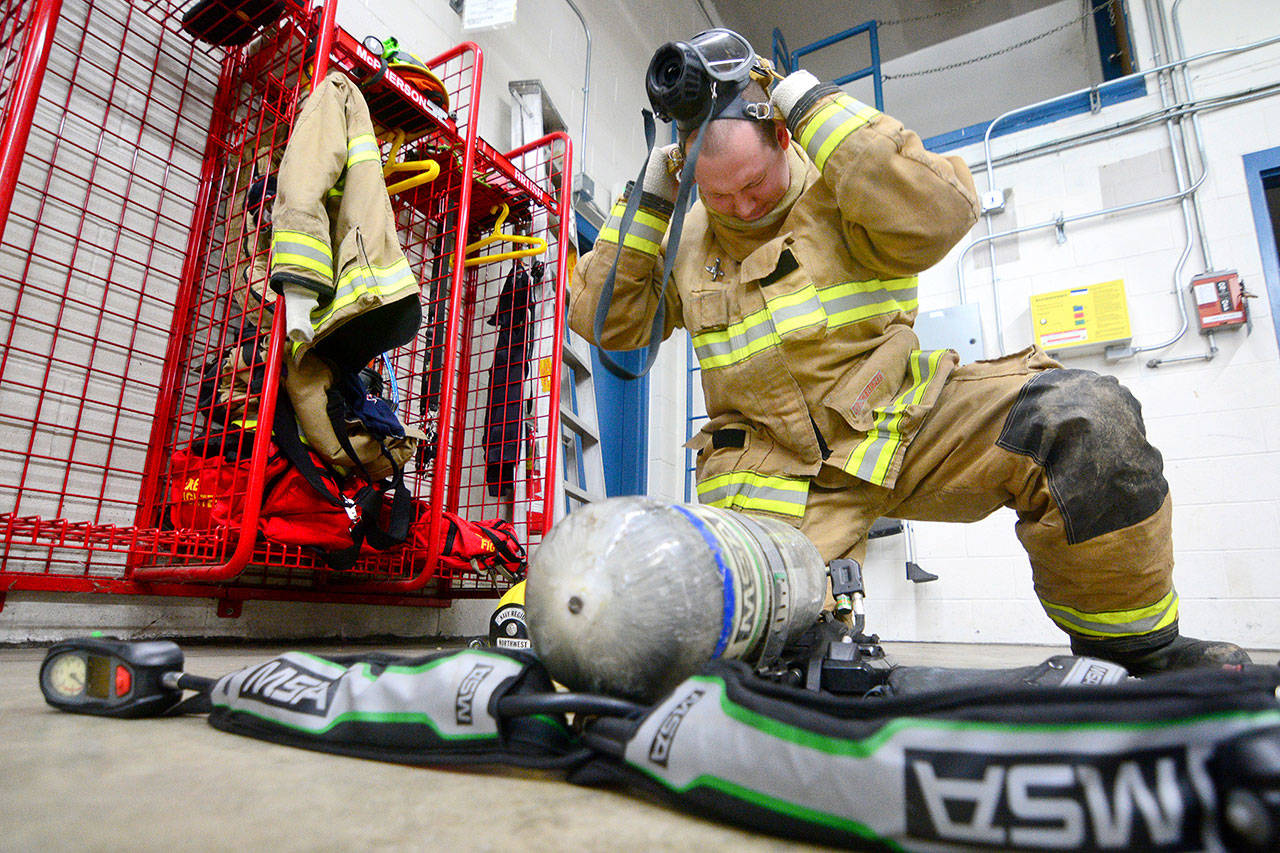PORT HADLOCK — Crews at the Naval Magazine Indian Island fire station would have very few calls if they weren’t committed to helping the outside community.
The 10-person fire station responded to 233 calls for service last year, 88 percent of which were off the military installation.
They had only 27 calls on Indian Island last year.
“If somebody here on base were to have a heart attack, they would feel much better knowing that a crew that goes out and deals with that on a regular basis is now there to help them,” said Capt. Bill Brush of the fire department. “We like to become better at our jobs.”
Indian Island’s fire station is one of 11 Navy Region Northwest Fire and Emergency Services stations distributed among nine Navy installations. The fire department, staffed by Navy civilians, serves Jefferson, Kitsap, Snohomish and Island counties.
The Navy fire department maintains more than 40 mutual-aid agreements with jurisdictions across Puget Sound.
Through mutual-aid agreements with surrounding fire districts, the fire station responds alongside East Jefferson Fire-Rescue, Port Ludlow Fire & Rescue, Brinnon Fire Department and Quilcene Fire Department, though that hasn’t always been the case.
Brush estimated that when he first began at Naval Magazine Indian Island fire station, about 80 percent of the calls crews responded to were on base, meaning there were very few calls.
Brush said firefighters pushed for the mutual-aid agreements because they enjoy their jobs and the extra calls keep their skills sharp.
“This partnership is win-win,” said East Jefferson Fire-Rescue Chief Jim Walkowski. “The level of service that Naval Magazine firefighters and Engine 91 provide to our community is significant. The entire community is impressed by their service.”
Depending where an incident happens, Navy firefighters may be the first on-scene. They are often first on scene for incidents on Marrowstone Island, firefighters said.
“Our Marrowstone Island fire station is an all-volunteer force with a limited volunteer recruitment demographic,” Walkowski said. “Engine 91 is strategically located to access Marrowstone Island.”
When Naval Magazine’s Engine 91 arrives on scene, there are four qualified firefighters on board. The station has one fire engine, one brush truck for wildland fighting and one rescue truck.
The Navy firefighters are also trained to work hazardous materials response.
At the same time local firefighters provide advanced life support and paramedics to Navy installations around the Puget Sound.
The majority of calls on base are either medical or fire alarm malfunctions, firefighters said. There are few fires on base because of safety measures and the lack of housing on the island, they said.
“The [Department of Defense] as a whole is very fire-safety-centric, so we have redundancies on redundancies to help prevent loss of property,” said firefighter Benjamin Slater.
Once most of the approximately 160 people who work on the island — most of whom are civilians — leave work for the day, there is little risk for emergencies on the island that firefighters would respond to, according to firefighters.
At any given time there are four firefighters and one captain working. They work 48-hour rotational shifts with three-day breaks.
On every third rotation they only have two-day breaks. The end result is everyone ends up working with everyone and no two consecutive days are the same.
“The fire department is technically our home away from home,” Brush said.
While the firefighters are committed to helping the community, their first priority is serving Naval Magazine Indian Island.
If the installation’s crews are loading ordnance on or off a ship at the ammo pier, fire crews are standing by and let Jefferson County dispatchers know they are out of service.
If there is a serious emergency in the community and Engine 91 is needed, the captain will ask Naval Magazine Indian Island’s Commanding Officer Cmdr. Rocky Pulley whether firefighters are authorized to leave the installation.
“These professionals provide a great service to the communities in the area and anytime we are not conducting conventional ordnance operations, they are free to perform mutual aid with [Jefferson County] as many times as they need to,” said Pulley, who took command of the installation in July.
Pulley said that — though it doesn’t happen often — if there is a serious emergency he will stop the ordnance operations that require firefighters to be present. For that to happen it would typically need to be a life-or-death situation.
“I’ll make that call,” Pulley said.
To build relationships prior to arrival at an incident, the local fire chiefs meet monthly to discuss their ongoing operational and training needs.
Pulley said he attended one of the meetings in Brinnon, where he met all the local fire chiefs.
“The coordination between all the chiefs and all the departments in [Jefferson County] is pretty eye-watering in how well they talk to each other and are able to work alongside each other,” Pulley said.
________
Reporter Jesse Major can be reached at 360-452-2345, ext. 56250, or at jmajor@peninsuladailynews.com.

